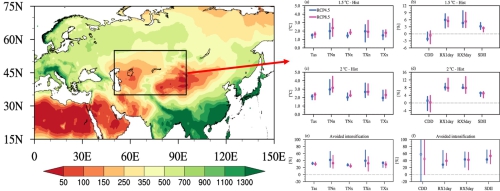Half a Degree Less Warming Can Significantly Reduce Climate Extremes in Central Asia
Date:2019-11-20
To avoid the dangerous impact of global warming, the 2015 Paris Agreement committed to “holding the increase in the global average temperature to well below 2 °C above preindustrial levels and pursuing efforts to limit the temperature increase to 1.5 °C above preindustrial levels”. Arid Central Asia is the geographical core region of the Silk Road Economic Belt which bridges the economic development across the Eurasian continent. Information on climate change in this region is quite important to the broad communities participating in the Belt and Road Initiative.
"However,how extreme events will change in this region in the future has not been investigated in detail so far", said Dr. PENG Dongdong from the Institute of Tropical and Marine Meteorology, China Meteorological Administration, Guangzhou. "How will the high impact climate extremes in Central Asia change during the coming century? And especially what is the influence of 0.5℃ less global warming?"
In a recent study published in Climate Dynamics,Dr. PENG and co-authors from the Institute of Atmospheric Physics (IAP), Chinese Academy of Sciences (CAS) answer these questions.
According to this research, Central Asia will witness a significant increase in both rainfall and temperature extremes in response to continuing global warming during the 21st century, and the intensification of extremes will be reduced by more than 24% if the global warming level can be committed to 1.5 ℃ instead of 2 ℃.

The changes in climate extremes over Central Asia in 1.5 and 2 ℃ warmer worlds. (Image by PENG Dongdong)
"A low warming target is necessary for avoiding the dangerous risk of extremes in this arid region", said Dr. PENG.
Model simulations from the Coupled Model Intercomparison Project phase 5 (CMIP5) show obvious biases in simulating the historical climate extremes in Central Asia. Thus, the team employed an observationally-constrained method to correct the potential biases of future projections in this study.
"There is an obvious difference between the bias-corrected and uncorrected results. For instance, as compared to the uncorrected projections, the corrections indicate rainfall extremes in Central Asia are more sensitive to global warming, whereas less sensitive for temperature extremes cases", said Dr. PENG.
The model biases seen in historical simulations could result in great influence in future projections. "To achieve more accurate information on future climate change, an efficient way is employing an observationally-constrained method", Dr. PENG emphasized. "It’s worth conducting more studies to further improve the accuracies of future projections."
Citation:
